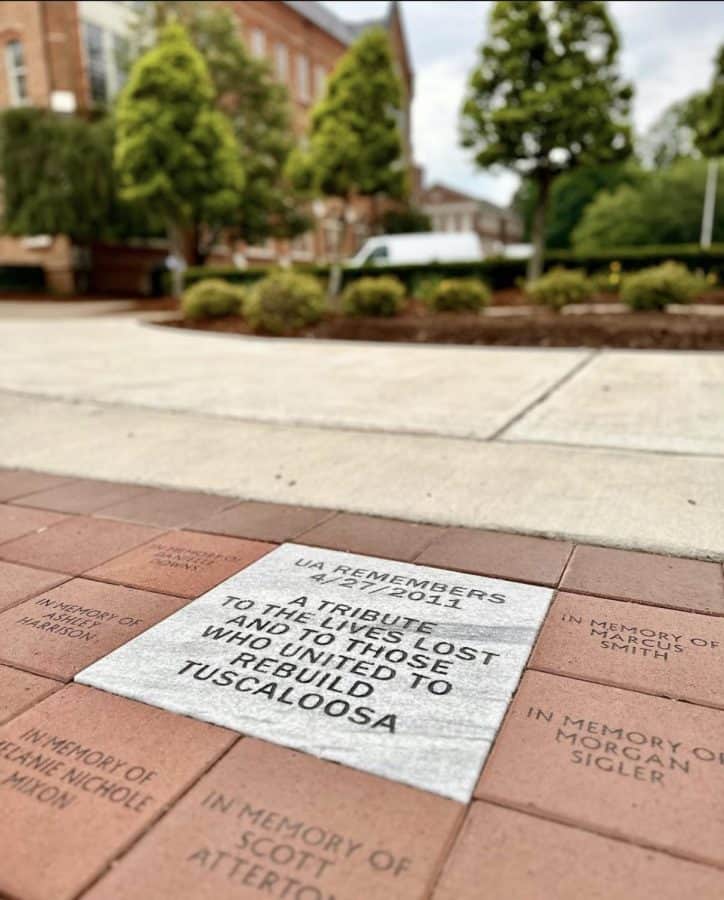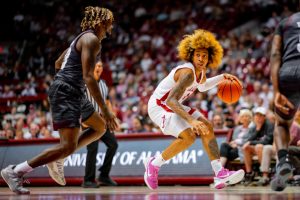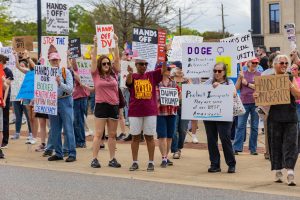12 years later: How the April 27, 2011, tornadoes affected UA
A tile at the front and center of the Crimson Promenade remembers the lives lost in the 2011 tornadoes. / UA Instagram
May 6, 2023
The beginning
It was Wednesday, April 27, 2011.
Speculation of tornadoes forming had arisen, but many Tuscaloosa residents didn’t give this much thought.
It was tornado season in the South, after all, and false alarms had been occurring all week with watches that amounted to little rain.
It was anything but a normal morning as WVUA’s chief meteorologist, Richard Scott, entered the studio. The forecast suggested severe weather with a high risk of multiple tornadoes. Scott knew it was going to be a bad day.
He was right. The sky quickly darkened to be draped with ominous, gray clouds.
Scott stood looking at the sky tower camera images across Tuscaloosa from the studio located on the bottom floor of Bryant-Denny Stadium. He felt safe in the studio, but knew he had to warn others to immediately find a safe place.
As viewers tuned in, they soon realized Scott meant business in front of the live images of a large funnel slowly touching down in Tuscaloosa, near The University of Alabama’s campus.
Standing without his coat on, Scott urged locals to take cover as the first round of a super tornado outbreak began rampaging throughout the South. The first round on the morning of April 27 lasted from 3 to 7 a.m. and caused multiple deaths.
“The morning round was so significant that the looming afternoon round worried me even more because its stability was going to be higher and the parameters were going to be much worse,” Scott said.
Round two
As the first tornado flattened houses, leveled streets, and killed residents, rain continued to beat down on Tuscaloosa, but the terror was just getting started.
The second round of tornadoes followed that afternoon.
“The afternoon round was a supercell event with multiple supercells and long-track, violent tornadoes. Nearly every storm had a tornado, which is incredibly rare. That doesn’t typically happen,” Scott recalled.
According to the National Weather Service, these tornadoes were supercell storms, or severe thunderstorms that create multiple, long-lasting tornadoes, high winds and hail. These storms are rare, and they tend to occur in the area known as Tornado Alley, located in the Central United States.
As Scott stayed on air in the early afternoon during the storms, he kept hearing the National Weather Service describe a “large, violent tornado.” He knew the afternoon round was going to be much worse.
Scott knew more people were going to lose their lives and homes, but there was nothing he could do to prevent this, except warn people to shelter in place.
“We could see the tornado when it was 20 miles away from our tower cam. This was the first time I had ever seen a tornado that far away, live on our tower cam,” Scott said.
But according to Scott, Tuscaloosa was lucky. There was more than enough time to warn the public to be weather aware and take shelter.
“We had ample warning. There was over a one-hour warning for the tornado that hit Tuscaloosa, which is incredible. You typically don’t have a warning that far in advance,” Scott said.
As he watched the growing tornado continue to descend on his beloved city, Scott described the panic that settled throughout his body.
“My heart sank deep in my chest — deep in my stomach — because you know that people are going to die,” Scott said. “Some people are going to do everything right, but there’s not going to be anything left of their house with a tornado that large.”
The station lost power briefly, but quickly regained its spot on-air. WVUA now has a backup generator in case it is hit again in the event of a natural disaster.
The tornadoes wreaked havoc on the town, killing 64 people, with six of the victims being students at the University. The tornado also destroyed everything in its path, including Scott’s house.
Scott had become a homeowner ten months earlier, but in a split second, everything he had worked for was obliterated.
While Scott was on air, his station director happened to be at Scott’s house when the tornado hit. The station director was living with Scott at the time.
Even though Scott lost his home, he said he was proud of the way his station director followed tornado safety precautions by hiding in the bathtub. Scott said this decision ultimately saved his station director’s life.
As the tornadoes died down and the wind stopped, the aftermath of the destruction began to weigh down on the community. Cleanup and rebuilding began, and Tuscaloosa slowly returned to normal, but nothing would ever be the same.
UA’s response
As the years passed, The University of Alabama has taken many precautions to ensure the safety of its students after six UA students were killed in the 2011 tornado.
Shane Dorrill, an assistant director of communications for the University, said via an email statement that the University’s Office of Emergency Management is in direct contact with the National Weather Service.
Students have access to the UA Safety app, as well as emails, phone calls and text messages when a severe weather threat is detected.
After 2011, the University built nine campus storm shelters, and Dorrill said there are plans to build three more. Previously, the campus had no shelters.
These locations can be found online, along with an explanation of what the difference between a watch and a warning is.
“During Bama Bound, safety information is shared with students and their parents who attend. Students and their parents are encouraged to download and use the UA Safety app and to read the UA Safer Living Guide,” Dorrill explained.
Along with these shelters, UA has also established best available refuge areas in many buildings.
These areas have been identified as the best area to shelter in place if you are stuck in a building that does not have a storm shelter during severe weather. The location of the BARAs can be found online, as well as on the building emergency plan located inside each campus building.
The best thing students can do to ensure their safety during severe weather is to stay alert and weather aware.
“If a tornado watch or warning is issued for the campus area, a UA Alert will be sent,” Dorrill said. “Students should make sure their contact information is updated in myBama so they can receive UA Alerts.”
Student fears
Although the University is doing everything in its power to keep people safe during severe weather, some students still have their concerns.
Megan Pelton, a senior majoring in kinesiology from Utah, said she had never experienced tornado season before coming to Alabama.
Pelton said that she is used to facing hail and snow back home, but not the tornadoes for which the South is infamous.
“I wasn’t prepared to deal with tornadoes until I moved here and then I had to quickly adapt,” Pelton said.
There were a lot of bad storms and tornado warnings during Pelton’s first spring in Tuscaloosa.
Pelton said her first experience with a tornado warning scared her because she had heard stories of everything being destroyed.
“You hear the sirens and they are super ominous,” Pelton said. “They sound so terrifying. The sky was green. There was no more wind and the birds were silent. All you can hear is the echo of the siren and you know it’s close.”
There was nothing that could have made Pelton feel prepared for this experience. No amount of training or weather alerts could have prevented her from feeling this way.
Although she feels more prepared after her tornado warning experience, Pelton said she still fears that other out-of-state students do not take tornado season seriously.
The impact
As Richard Scott reflected on his experience on air 12 years later, he admitted the event changed how he approaches meteorology.
“Before 2011, I used to get excited about severe weather. I would look forward to it because there is an adrenaline rush when it comes to covering severe weather,” Scott confessed.
After he saw the destruction and death toll and experienced his own loss of property after the storm, Scott changed his mindset.
“Whenever there is a possibility for severe weather, I wish it away,” Scott said.
The only thing Scott can do is warn others to be weather aware by having a way to receive weather alerts, having a place to go in the event of severe weather and remaining calm.
Scott has a feeling of helplessness when he has to warn people to grab their bike helmets and head to their safe place.
However, he still takes off his coat and continues to do his job, warning people about weather events like he did that Wednesday 12 years ago.





















